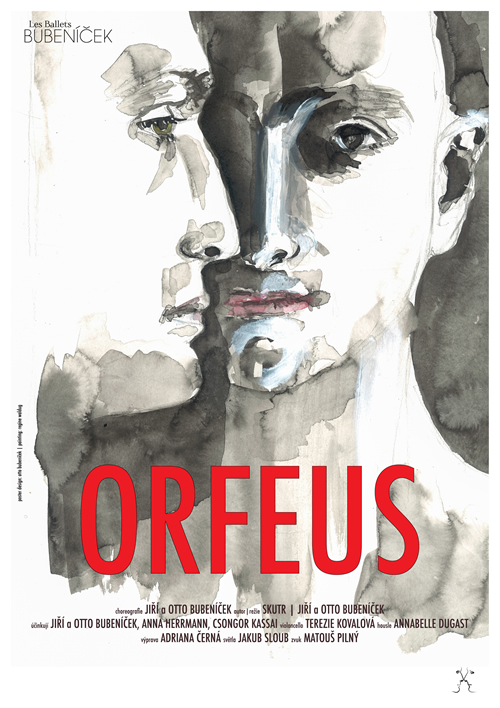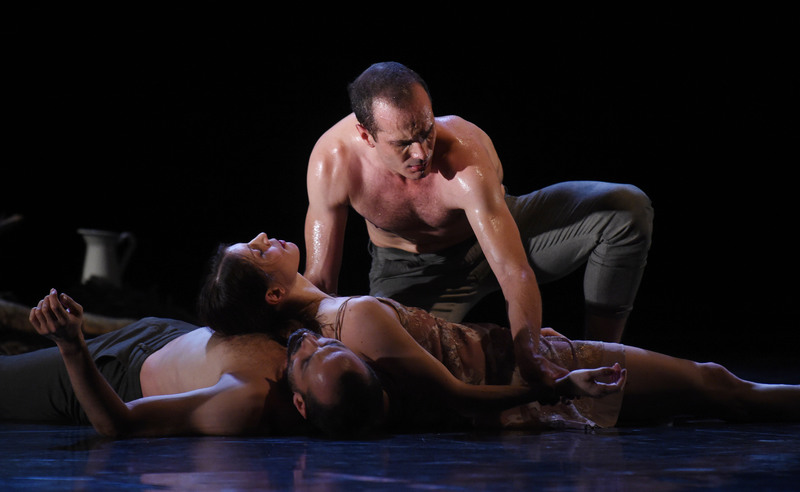 The famous ballet twins, brothers Jiří and Otto Bubeníček, decided to end their professional dance career this year with a brand-new piece, specially created for this occasion. Their Orpheus, variation on an Ancient myth, touches almost all senses and constantly stimulates the viewer’s imagination. The project is to be presented in several Czech and Slovak towns. The tour started on 8 September 2016 at Flora Olomouc Exhibition Grounds and also in Ostrava’s Gong it aroused many expectations along with the nostalgia after the closing meteoric career and the years when the name of the Bubeníček brothers was associated with the world’s most famous stages and choreographers. In Orpheus, the Bubeníček brothers were joined by SKUTR, the well-known tandem of directors (Martin Kukučka and Lukáš Trpišovský), the German dancer Anna Herrmann, Slovak actor Csongor Kassai and two musicians – violinist Annabelle Dugast and cellist Terezie Kovalová.
Dancing musicians
The Bubeníček brothers who, besides dance, also focus on choreography, composition and scenography, were not afraid of trying new, unconventional artistic collaboration that resulted in a piece full of cross-genre features, interplay of movement, music, drama and visual art. Far from classical ballet and fixed forms, Orpheus finds inspiration in the mythic story and tries to retain its plot - not in a violent, superficial way but through more or less explicit images, gestures and symbols shaped by the dancers’ bodies, by music and voice. Eurydice, who is taken back from the Underworld by her husband Orpheus, was portrayed by Anna Herrmann. The former member of the Netherlands Dance Theatre was able to express the loving trust of the dead girl, the almost naïve affection and vulnerability, thanks to her fragile beauty and animalistic plasticity of movement. Her pureness corresponded with the masculine energy of Jiří and Otto Bubeníček who could, (not only) thanks to their physical likeness, play with scenes of the double self or contrast of reality and memory (or thought). The story initiator Csongor Kassai (the Narrator) manipulated the characters by words and actions, although he lost his control sometimes. The indispensable part of the piece was the voice and music performed by Terezie Kovalová and Annabelle Dugast who also took on the roles of dancers, their instruments turned into essential props and their music completed the choreographic images.
Retiring in brilliant form
The famous ballet twins, brothers Jiří and Otto Bubeníček, decided to end their professional dance career this year with a brand-new piece, specially created for this occasion. Their Orpheus, variation on an Ancient myth, touches almost all senses and constantly stimulates the viewer’s imagination. The project is to be presented in several Czech and Slovak towns. The tour started on 8 September 2016 at Flora Olomouc Exhibition Grounds and also in Ostrava’s Gong it aroused many expectations along with the nostalgia after the closing meteoric career and the years when the name of the Bubeníček brothers was associated with the world’s most famous stages and choreographers. In Orpheus, the Bubeníček brothers were joined by SKUTR, the well-known tandem of directors (Martin Kukučka and Lukáš Trpišovský), the German dancer Anna Herrmann, Slovak actor Csongor Kassai and two musicians – violinist Annabelle Dugast and cellist Terezie Kovalová.
Dancing musicians
The Bubeníček brothers who, besides dance, also focus on choreography, composition and scenography, were not afraid of trying new, unconventional artistic collaboration that resulted in a piece full of cross-genre features, interplay of movement, music, drama and visual art. Far from classical ballet and fixed forms, Orpheus finds inspiration in the mythic story and tries to retain its plot - not in a violent, superficial way but through more or less explicit images, gestures and symbols shaped by the dancers’ bodies, by music and voice. Eurydice, who is taken back from the Underworld by her husband Orpheus, was portrayed by Anna Herrmann. The former member of the Netherlands Dance Theatre was able to express the loving trust of the dead girl, the almost naïve affection and vulnerability, thanks to her fragile beauty and animalistic plasticity of movement. Her pureness corresponded with the masculine energy of Jiří and Otto Bubeníček who could, (not only) thanks to their physical likeness, play with scenes of the double self or contrast of reality and memory (or thought). The story initiator Csongor Kassai (the Narrator) manipulated the characters by words and actions, although he lost his control sometimes. The indispensable part of the piece was the voice and music performed by Terezie Kovalová and Annabelle Dugast who also took on the roles of dancers, their instruments turned into essential props and their music completed the choreographic images.
Retiring in brilliant form
 Orpheus‘s journey to the Underworld and getting close to the very essence of human life take place on a stage dominated by natural elements – remains of roots and earth, water that washes away all the wrong, fire of life and fire of burial candles… all this gradually penetrates the relations of the protagonists – relations between a man and woman, father and son, mother and child. All from passionate love and unstable emotions to dark sides of the human soul, fear and anger. The individual images change without interruption or pause, though the transitions sometimes seem unnatural and calculated. Too many ideas offered at once make the viewer’s eyes drift on the stage and focus on insignificant details. The direction strategies of SKUTR are marked by originality, typical use of various ‘non-theatrical’ objects (often movement-restraining and limiting) which results, eventually, in more authentic stage presence. The performers need to adjust their moves to the caprices of natural materials and have no time left for pretended authenticity - everything comes naturally. At the same time, the elements take us to the very core of human existence, freed from the many layers of civilisation. Suddenly, there is just the body, space, time and energy.
Orpheus‘s journey to the Underworld and getting close to the very essence of human life take place on a stage dominated by natural elements – remains of roots and earth, water that washes away all the wrong, fire of life and fire of burial candles… all this gradually penetrates the relations of the protagonists – relations between a man and woman, father and son, mother and child. All from passionate love and unstable emotions to dark sides of the human soul, fear and anger. The individual images change without interruption or pause, though the transitions sometimes seem unnatural and calculated. Too many ideas offered at once make the viewer’s eyes drift on the stage and focus on insignificant details. The direction strategies of SKUTR are marked by originality, typical use of various ‘non-theatrical’ objects (often movement-restraining and limiting) which results, eventually, in more authentic stage presence. The performers need to adjust their moves to the caprices of natural materials and have no time left for pretended authenticity - everything comes naturally. At the same time, the elements take us to the very core of human existence, freed from the many layers of civilisation. Suddenly, there is just the body, space, time and energy.
In Orpheus, love is the emotion that appears in many forms. The legend of Orpheus itself tells the story of love that wins over death. On stage we can see not only the love for a human, but also love for art, dance, music and the respect to the moment of performance. There is no doubt that all the artists involved in the project are professionals and masters of their craft. That is why they can experiment and their presence on stage is enough to realise that something special, unrepeatable, is going on. The fact, that the Bubeníček brothers still create and explore, that these classically trained dancers dare to try contemporary dance and dance theatre, shows their love for the art. They are retiring from the limelight in the best form, rewarded by standing ovations in Ostrava (and not only there).
Written from the performance held on 10 September, 2016, in Multifunctional Auditorium Gong.
Orpheus
Authors: Jiří and Otto Bubeníček, SKUTR
Choreography: Jiří and Otto Bubeníček
Direction: SKUTR (Martin Kukučka, Lukáš Trpišovský)
Violoncello: Terezie Kovalová
Violin: Annabelle Dugast
Production: JT Promotion
Premiere: 8 September 2016
Translation: Tereza Cigánková
Authors: Jiří and Otto Bubeníček, SKUTR
Choreography: Jiří and Otto Bubeníček
Direction: SKUTR (Martin Kukučka, Lukáš Trpišovský)
Violoncello: Terezie Kovalová
Violin: Annabelle Dugast
Production: JT Promotion
Premiere: 8 September 2016
Translation: Tereza Cigánková



